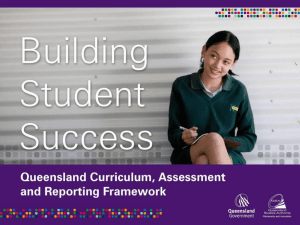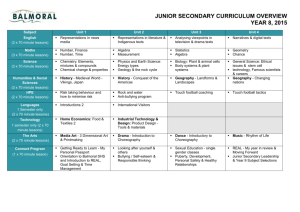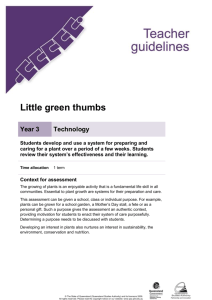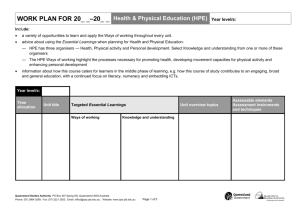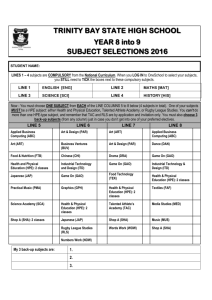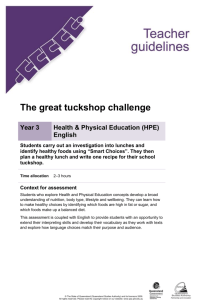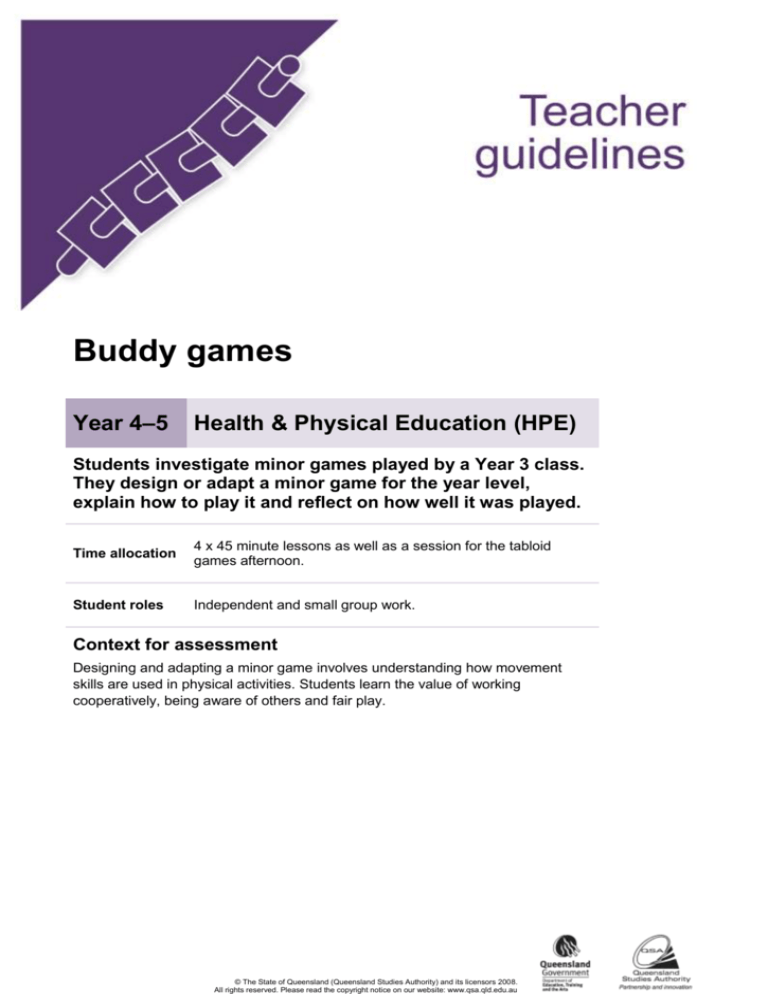
Buddy games
Year 4–5
Health & Physical Education (HPE)
Students investigate minor games played by a Year 3 class.
They design or adapt a minor game for the year level,
explain how to play it and reflect on how well it was played.
Time allocation
4 x 45 minute lessons as well as a session for the tabloid
games afternoon.
Student roles
Independent and small group work.
Context for assessment
Designing and adapting a minor game involves understanding how movement
skills are used in physical activities. Students learn the value of working
cooperatively, being aware of others and fair play.
© The State of Queensland (Queensland Studies Authority) and its licensors 2008.
All rights reserved. Please read the copyright notice on our website: www.qsa.qld.edu.au
Teacher guidelines
This assessment gathers evidence of learning for the following Essential Learnings:
HPE
Essential Learnings by the end of Year 5
Ways of working
Knowledge and understanding
Students are able to:
Physical activity
collect, organise and evaluate
information and evidence
Fundamental and simple specialised movement skills
are elements of physical activity.
propose, justify and implement
simple plans or actions to
promote health and wellbeing,
movement capacities, and
personal development
Application of appropriate techniques for fundamental
and simple specialised movement skills can enhance
physical performance and participation in physical
activities.
apply fundamental and simple
specialised movement skills
when participating in physical
activities
Working cooperatively, and being aware of others
and fair play, can enhance the experience of physical
activities for individuals and groups.
identify and apply safe practices
reflect on and identify how their
own and others’ behaviours,
skills and actions influence
health and wellbeing, movement
capacities and personal
development.
Assessable elements
Knowledge and understanding
Investigating
Planning
Implementing and applying
Reflecting.
Source: Queensland Studies Authority 2007, HPE Essential Learnings by the end of Year 5, QSA, Brisbane.
2
Year 4–5 HPE: Buddy games
Links to other KLAs
This assessment could be expanded to assess the following Essential Learnings:
English
Essential Learnings by the end of Year 5
Ways of working
Knowledge and understanding
Students are able to:
Writing and designing
identify the relationship
between audience, purpose
and text type
Writing and designing involve using language elements
to construct literary and non-literary texts for audiences
in personal and community contexts.
identify main ideas and the
sequence of events, and
make inferences
The purpose of writing and designing includes
entertaining, informing and describing.
construct literary and nonliterary texts by planning and
developing subject matter,
using personal, cultural and
social experiences that
match an audience and
purpose
Writers and designers can adopt different roles, and
make language choices appropriate to the audience.
Text users make choices about grammar and
punctuation, to make meaning.
Sound, visual and meaning patterns, including word
functions, are used to spell single-syllable and
multisyllable words.
Writers and designers refer to authoritative sources and
use a number of active writing strategies, including
planning, drafting, revising, editing, proofreading,
publishing and reflecting.
reflect on and describe the
effectiveness of language
elements and how the
language choices represent
people, characters, places,
events and things in
particular ways.
Language elements
Interpreting and constructing texts involve making
choices about grammar, punctuation, vocabulary, audio
and visual elements in print-based, electronic and faceto-face modes (speaking and listening, reading and
viewing, writing and designing) in personal and
community contexts.
Text connectives signal how things, ideas and
information are related.
Vocabulary is chosen to express ideas and information in
a commonsense or technical way.
Literary and non-literary texts
Making choices about literary and non-literary texts
involves identifying the purpose, audience, subject
matter and text structure.
Non-literary texts report, inform, present and seek
opinions, present arguments, persuade and negotiate.
Source: Queensland Studies Authority 2007, English Essential Learnings by the end of Year 5, QSA, Brisbane.
3
Teacher guidelines
Listed here are suggested learning experiences for students before attempting this assessment.
Explore minor games and identify and explain details needed to adapt or design a minor game
that includes movement skills and sequences.
Analyse a minor game and identify movement skills and sequences, rules, equipment and
safety considerations.
Identify appropriate language choices for procedural texts, such as verbs and connectives,
technical or specialist language, timeless present tense, implied second person, and
sequencing.
Practise how to reflect on the playing of the minor game and the explanation of how to play,
which will include accepting feedback and making observations.
Teacher resources
Listed here are suggested resources that students will need prior to and during the assessment:
sample minor games (e.g. static balance — stuck in the mud, statues; vertical jump —
skipping, elastics, hoop jump, leap frog, sack races; catch — bean bag drop, hot potato; hop,
skip and side gallop — hopscotch, follow the leader, obstacle course, dance; overarm throw —
targets, goal shooting, throw for distance; kick — balloon kicks, bull’s eye; two-handed strike —
target ball, sock hockey; dodge — treasure chest, run to touch, shadow tag, tiggy; combination
of skills — kick and catch, name it, backyard cricket, volleyball)
sample instructions (e.g. charts on how to write instructions)
magazines etc. for pictures
library and internet
sports equipment.
4
Year 4–5 HPE: Buddy games
Preparing
Consider these points before implementing the assessment.
Promoting Health and Physical Education lays the foundations for a healthy and active lifestyle.
At this stage, students have developed fundamental and simple specialised movement skills
such as running, hopping, jumping, skipping, catching, throwing, kicking, rolling, balancing,
twisting and turning as well as the capacity to link these skills into more complex and
coordinated movement skills and sequences. Students develop a growing movement
vocabulary, including motor terms and ways of describing the physical responses of their
bodies to movement and feelings associated with participation in physical activity.
This assessment enables students to investigate these movement capacities and develop a
movement vocabulary through the evaluation and planning of a minor game for students in a
lower year level. In addition, the development of an understanding of movement capacities
increases the students’ knowledge of rules and safety while promoting physical activity and
health.
Safety will need to be a prime consideration in this assessment. Students will need to consider
carefully the movement skills and sequences, and the equipment. A formal risk assessment for
each minor game prior to the tabloid games afternoon will need to be conducted, which can be
carried out in cooperation with the PE teacher.
Sample implementation plan
This table shows one way that this assessment can be implemented. It is a guide only — you may
choose to use all, part, or none of the table. You may customise the table to suit your students and
their school environment.
Suggested time
Student activity
Teacher role
Section 1. Investigating minor games
30 minutes
In a small group students will
investigate minor games
suitable for Year 3.
Brainstorm possible answers
for minor games played by
Year 3.
15 minutes
Conduct a short survey using
the question provided. Collect
data and record it on the table.
Organise small groups.
Discuss minor games and
provide examples of suitable
minor games for Year 3
students.
Assist the students as they
conduct a survey.
5
Teacher guidelines
Section 2. Evaluating a minor game
45 minutes
In the same small group
complete an evaluation for
one minor game.
Monitor small groups. Assist
the students in evaluating one
minor game. Assist the
students in making group
decisions.
Section 3. Adapting or designing a minor game
45 minutes
In the same small group
students will decide on
whether to adapt or design a
minor game before beginning.
Monitor small groups. Assist
the students as they design or
adapt a minor game suitable
for Year 3 students.
They identify the equipment,
number of players, aim, length
of time, rules, movement skills
and safety of the minor game.
Use Section 2 to help.
Highlight the importance of
safety and fair play.
Then go outside (with
permission) to play and check
the minor game and explore
the movement skills and
sequences.
Section 4. Explaining how to play
45 minutes — more time will
be required if explanation is
typed.
Revise writing an explanation
of how to play a minor game.
Model how to write an
explanation of how to play a
minor game.
Individually draft and publish a
written explanation of how to
play the minor game, including
how to write instructions.
Assist students in writing an
explanation, including how to
write instructions for a game.
Observe the Year 3 class play
the adapted or designed minor
game.
Organise the tabloid games
afternoon with a Year 3 class.
Section 5. Reflecting
45 minutes — more time will
be required for the tabloid
games afternoon.
6
Monitor and assist students
Individually make observations where appropriate.
and collect feedback from the
Year 3 students about the
minor game. Complete the
reflection questions in section
5 of the Student booklet.
Year 4–5 HPE: Buddy games
During the learning process, you and your students should have developed a shared
understanding of the curriculum expectations identified as part of the planning process.
After students have completed the assessment, identify, gather and interpret the information
provided in student responses. Use only the evidence in student responses to make your judgment
about the quality of the student learning. Refer to the following documents to assist you in making
standards-referenced judgments:
Guide to making judgments
Indicative A response
Sample responses (where available).
Making judgments about this assessment
Teachers will need to monitor the input and participation of individual students within each small
group when making an overall judgment about the quality of student learning. Group work is
included in Sections 1 and 2 and is reflected in the Assessable elements of Investigating and
Planning on the Guide to making judgments.
Section 3 begins with the expectation that the small group will implement (play) their designed or
adapted game before students individually write an explanation on how to play. Sections 3 to 5 are
reflected in the Assessable elements of Implementing and applying and Reflecting on the Guide to
making judgments.
For further information, refer to the resource Using a Guide to making judgments,
available in the Resources section of the Assessment Bank website.
7
Teacher guidelines
Evaluate the information gathered from the assessment to inform teaching and learning strategies.
Involve students in the feedback process. Give students opportunities to ask follow-up questions
and share their learning observations or experiences.
Focus feedback on the student’s personal progress. Emphasise continuous progress relative to
their previous achievement and to the learning expectations — avoid comparing a student with
their classmates.
Giving feedback about this assessment
Reflection is an integral component of this assessment as students design or adapt a minor game
for a younger year level and experience the value of working cooperatively, being aware of others
and fair play. This process provides an opportunity to promote self-assessment principles.
For further information, refer to the resource Using feedback, available in the
Resources section of the Assessment Bank website.
8

